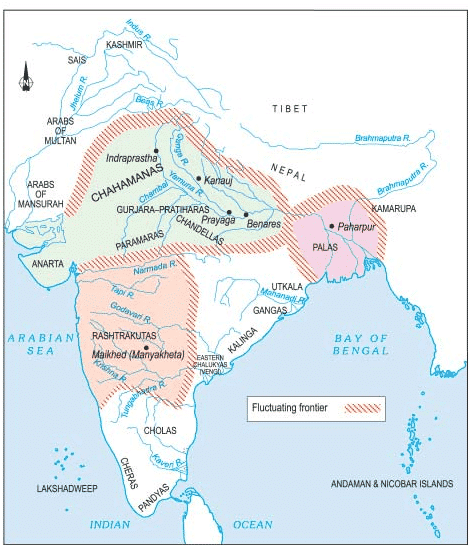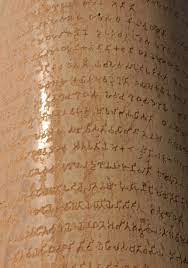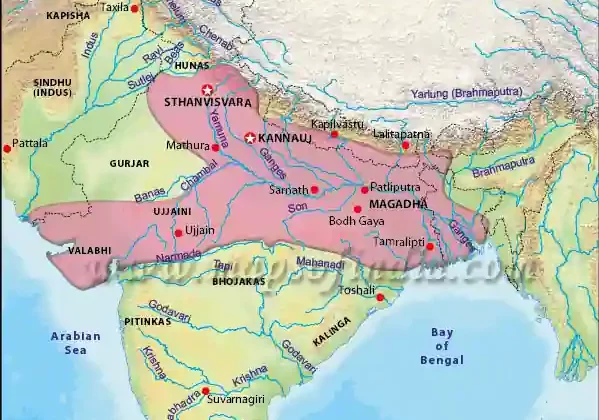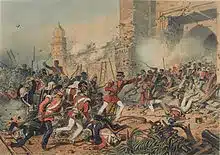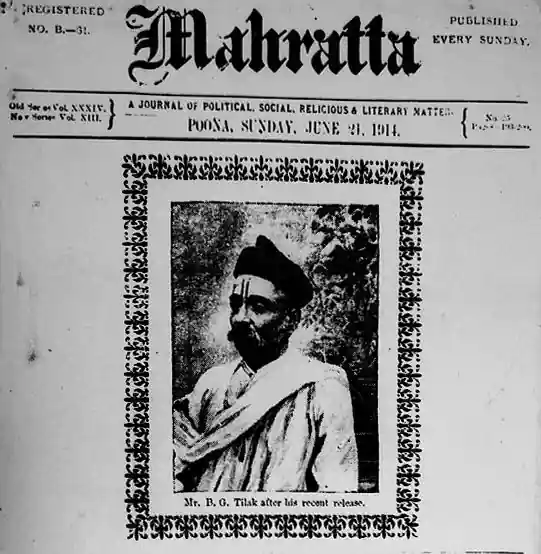The Kushans (1st to 3rd Century A.D.)
- The Kushanas were also referred as Yueh–Chis (Moon tribe) or Tocharians, who were one of the five clans (Kuei-shang) into which the Yue-chi tribe was divided. They were nomadic tribal people who were originally from the steppes of north Central Asia.
- The Kushanas first occupied Bactria (or north Afghanistan), where they displaced the Shakas, and gradually seized Gandhara, replacing the rule of the Greeks and the Parthians in these areas. Ultimately, they set up their authority over the lower Indus basin and the greater part of the Gangetic basin.
- Their empire extended from the river Oxus to the river Ganga, from Khorasan in Central Asia to Varanasi in Uttar Pradesh (almost the area of nine modern countries).
- Like the Sakas and Pahlawas, the Kushanas too are mentioned in Epic, Puranic and other lilterature.
- The Kushana rule is particularly significant because under them, civilisations of the Mediterranean world, Western Asia, Central Asia, China and India got assimilated.
- Kujala Kadphises and Kanishka-I adopted and patronized the Buddhism, but Vima Kadphises adopted Shaivism and was a Shiva Devotee.
prominent Kings of Kushans
Kujula Kadphises/Kadphises I (15 CE – 64 CE)
- He amalgamated the five clans of Yue-chi tribe and laid the foundations of a unified Kushana empire.
- He minted coins in copper and believed to have imitated the Roman ‘aurei’ type coins to facilitate trade.
- His coins have been found south of the Hindu Kush, which suggests that during his reign the Kushanas probably started their movement towards Indian sub-continent.
- His coins also suggest an association with Buddhism.
- He adopted the epithet ‘dharmathida’ and ‘sachadharmathida’.
- He was succeeded by his son Vima Taktu or Sadashkana (AD 80 -AD 95) who expanded the empire into northwest India.
Vima Kadphises/Wema Kadphises II (64CE – 78 CE)
- An inscription found at Rabatak in Afghanistan mentions that he was the son of Vima Taktu and the father of Kanishka.
- A large number of Roman gold coins found from this era indicate the prosperity of India at that time and also the growing trade with the Romans.
- He issued a large number of gold coins.
- He was a firm devotee of Shiva and proclaimed himself as ‘Mahishvara’ on his coins.
- All his coins (both gold and copper) have an unmistakable signs of Shiva with his trident bull.
Kanishka (78CE – 101 CE)
- Kanishka is the most popular Kushana ruler, particularly because of his association with Buddhism. The Kushanas reached the zenith of their power under Kanishka.
- He was the son of Vima Kadphises and is perhaps the most famous Kushana king, under whose reign the Kushana empire reached its zenith.
- The centre of this huge empire was Bactria, as evident in the use of the Bactrian language in Kanishka’s coins and inscriptions.
- The famous Rabatak Inscription (in modern Baghran province, Afghanistan) presents valuable information on Kanishka.
- Adopted the title of ‘Devputra’, and has been shown wearing a ‘peaked helmet’ on some coins.
- This period is historically significant for general cultural development in northern India as well as the intermingling of peoples of different geographical regions.
- The first capital of Kanishka was at Purushapura near modern Peshawar, where he erected a monastery’ and a huge stupa. Mathura appears to have been the second capital.
Kanishka’s Conquests
- At the time of his accession his empire included Afghanistan, Gandhara, Sind and Punjab.
- Subsequently, Kanishka conquered Magadha and extended his power as far as Pataliputra and Bodh Gaya.
- According to Kalhana, Kanishka invaded Kashmir and occupied it.
- Kanishka coins are found in many places like Mathura, Sravasti, Kausambi and Benares and therefore, he must have conquered the greater part of the Gangetic plain.
- Kanishka also fought against the Chinese and acquired some territories from them.
- During the first expedition, Kanishka was defeated by the Chinese general Pancho. Kanishka undertook a second expedition in which he was successful and he scored a victory over Panyang, the son of Pancho.
- Kanishka annexed the territories of Kashgar, Yarkand and Khotan into his empire.
- The empire of Kanishka was a vast one extending from Gandhara in the west to Benares in the east, and from Kashmir in the north to Malwa in the south.
Headless Statue at Mathura
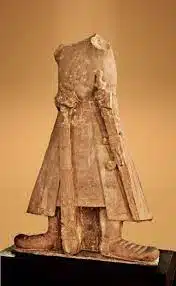
- A large size headless statue of Kanishka was found in the village Mat, near Mathura by Pandit Radha Krishna in 1911.
- According to Romila Thapar, the statue represents “the king as an impressive figure in boots and coat.”
- There are other features in addition to the boots and the coat. A.L. Basham draws our attention to his “grasping in one hand a sword and in the other its sheath, the king stands with legs apart, in an attitude of authority.”
- The most surprising thing is that only the head and hands are missing while the remaining statue is intact.
- According to A. L. Basham it was destroyed by the succeeding rulers. But then, why only head? Unfortunately, there is no authentic material to throw light on that question.
why the name Shaka era and not Kushana era?
- Started the Shaka era (78 CE), which is accepted as the beginning of his reign, and which is now used by the Government of India for its calendar.
- The probable explanation as to why the name Shaka era and not Kushana era probably lies in the belief that either Kanishka was mistakenly considered a Shaka, or that the era was in continuous use throughout the reigns of the Shakas kshatrapas of Western India, who acknowledged the overlordship of the Kushanas.
Kanishka and Buddhism
- Kanishka was a great patron of Mahayana Buddhism.
- Kanishka embraced Buddhism in the early part of his reign. However, Kanishka’s coins exhibit the images of not only Buddha but also Greek and Hindu gods.
- It reflects the Kanishka’s toleration towards other religions.
- Held the fourth Buddhist council at Kundalavana (near Srinagar in Jammu and Kashmir) under the presidency of Vasumitra.
- It was in this council that Buddhism was split into two schools – the Hinayana and the Mahayana.
- According to legends, it was Passa, a Buddhist monk who advised Kanishka to commence the fourth Buddhist Council.
Kanishka patronised
- Ashvagosha: A Buddhist scholar who wrote the hagiographic Buddhacharita (the sacred biography of the Buddha) and composed the Saundarananda (a Sanskrit kavya).
- Charaka: He is known as the father of Ayurveda who wrote a book on medicine called Charaksamhita and also wrote the Sasruta.
- Vasumitra:An eminent philosopher who authored the encyclopaedia of Buddhist philosophy called Mahavibhasa.
- Nagarjuna: He is often termed an Indian Einstein who proposed the Theory of Relativity in his time in the form of a Sutra, the Prajna Parimata Sutra. He was also a great exponent of the Mahayana doctrine and propounded the Madhyamaka (also known as Sunyavada School) which focuses on sunyata or emptiness
- Mathara: He was a minister who was noted for his unusual Intelligence.
- Agesilaus: A Greek engineer under whose guidance, it is believed, the great stupa of Purushapura was built.
- Kanishka also patronised the Gandhara and Mathura schools of sculpture. At Mathura, a headless statue of Kanishka depicting him as a warrior been found.
- He controlled the famous Silk Route in Central Asia. (China➝Central Asia➝Afghanistan➝Iran➝Western Asia (part of the Roman Empire)
Significance of the Kushana Empire
- Sanskrit literature began to be developed during this time. The fourth Buddhist council was held in Sanskrit.
- Ashvoghosha is considered to be the first Sanskrit dramatist.
- During this time, three distinct schools of art flourished: Gandhara School in northwest India, Amaravati School in Andhra and the Mathura School in the Yamuna valley.
- Trade prospered between India and China, and India and the Roman Empire.
- The Kushanas controlled large parts of the Silk Route which led to the propagation of Buddhism into China. It was during this time that Buddhism began to spread to Korea and Japan also.
- Many towers, Chaityas, towns and beautiful sculptures were built under the patronage of the Kushana kings.
- Kushanas were foreign invaders, to begin with, but they were completely Indianised in ways and culture.
- It is said that the Kushana period in Indian history was a perfect forerunner to the golden age of the Guptas.
- India was known as Shen-tu in the early Chinese texts.
- Sun God has been depicted on the coins of Kanishka-1 and Vāsishka.
- Sindoor (Vermillion) and Bamboo was introduced in India by Chinese traders.
- The central Asian Tribes introduced the Cap, Boot and helmet in India.
- Kushanas (Yueh Chi Tribe) is considered to have conducted the Horse trade by sea with the Koying kingdom of modern Malaysia.
Successors of Kanishka and end of Kushana Rule
- Kanishka was succeeded by his son Vasishka.
- Vasishka was followed by Huvishka and Kanishka II (son of Vasishka).
- Kanishka II was followed by Vasudeva I. Kanishka II assumed the title of Kaisar.
- Vasudeva was the last king of Kushan who died in 232 A.D. Though his name is after the Vaishnava deity, he was a Saiva.
- After his death, the Sasanian dynasty rose to power in Iran and North India and Kushan rule declined gradually.
Contributions of Kushan Empire
The Shaka-Kushana phase introduced various new elements to trade and agriculture, to administrative organisation, to art and literature, sculpture and pottery, science and technology, and to the Indian society at large. In fact, Central Asian influence was felt in almost all spheres and aspects of social life.
Pottery and Architecture:
- They introduced the use of burnt bricks for flooring and of tiles for both flooring and roofing.
- The period is marked by the construction of brick walls.
- Red pottery techniques, which were widely used in Central Asia, were replicated in the Indian Subcontinent too.
- The typical pottery of this period was red ware, both plain and polished with medium to fine fabric.
- The distinctive pots of this period are sprinklers and spouted channels.
Trade and Agriculture:
- Due to the establishment of intimate contacts between Central Asia and India, trade between the two regions also flourished.
- India imported a good deal of gold from the Altai mountains of Central Asia.
- Due to the extensive control of the Kushanas on the Silk Route, the economy of the Kushanas was replenished with the tolls levied from the traders and this income helped in building a large prosperous empire.
- It is rather pertinent to note that even though it was the Indo- Greeks who introduced gold coins in India, it was the Kushanas who were the first rulers in India to issue the gold coins on such a wide scale.
- The Kushanas also promoted agriculture. It is believed that the Kushanas were the pioneers in introducing and extending the areas under the large-scale irrigation.
Military Knowledge and Equipment:
- Being excellent horsemen themselves, the Shakas and the Kushanas introduced better cavalry and popularised the use of riding horses on a large scale.
- They made common the use of reins, saddles and toe-stirrups made of rope, which facilitated the movement of the rider.
- They also brought in caps, helmets, and boots used by warriors. The Shakas and Kushanas introduced new dressing styles such as the turban, the tunic, trousers, heavy long coats and long boots, which were adopted not only by warrior classes but also by certain other sections of the society.
- The practice of making leather shoes began in India during this period in all likelihood.
Administrative Organisation:
- The Kushans adopted the pompous title of ‘king of kings’, which indicates that they collected tributes from numerous small princes.
- The Shakas and Kushans strengthened the idea of the divine origin of kingship. Ashoka called himself ‘dear to the gods’, but the Kushan kings called themselves ‘Deviputra’, that is, the sons of god. This title was adopted by the Kushans from the Chinese, who called their king the son of heaven.
- It was naturally used in India to legitimize the royal authority. The brahmanical lawmaker Manu asks people to respect the king even if he is a child because he is a great god ruling in the form of a human being.
- The Kushans strengthened the satrap system of government adopted by the Shakas. The empire was divided into numerous satrapies, and each placed under the rule of a satrap. Some curious practices such as hereditary dual rule, that is, two kings ruling in the same kingdom simultaneously, were begun, with instances of father and son ruling jointly at the same time. It thus appears that there was less of centralization under these rulers.
- The Greeks also introduced the practice of military governorship, the governors called strategos. Military governors were necessary to maintain the power of the new rulers over the conquered people.
Indian Society:
- One of the striking aspect about the Central Asians conquerors was that not only did they assimilate with the India society, but they also added new ingredients to Indian culture and enriched it immensely.
- Since they did not have their own script, written language or any organised religion, they adopted these components of culture from India.
- It would be not wrong to state that in no other period of ancient history were foreigners assimilated in Indian society on such a large scale as they were in the post-Maurya period.
- Since most of them came as conquerors they were absorbed as kshatriyas.
- Even in the Manusmriti, the Shakas and Parthians are described by Manu as the vratya-kshatriyas (second class kshatriyas) who had deviated from their duties of sacrificial rituals and thus fallen in status.
- The rulers not only adopted the Indian societal norms but also adopted the popular religions of that time. For instance, some of them converted to Vaishnavism (the worship of Vishnu), as in the case of Greek ambassador Heliodorus who set up a pillar in honour of Vasudeva. A few others adopted Buddhism, as in the case of the Greek ruler Menander who became a Buddhist. Similarly, the Kushana rulers worshipped both Shiva and the Buddha and the images of these two gods appeared on the Kushana coins.
| Mauryan Empire | Sites Of Indus Valley Civilization |
| Vedic Period | Vedic Literature |
| Marriages In the Later Vedic Period | MCQs: History Of Ancient India |


